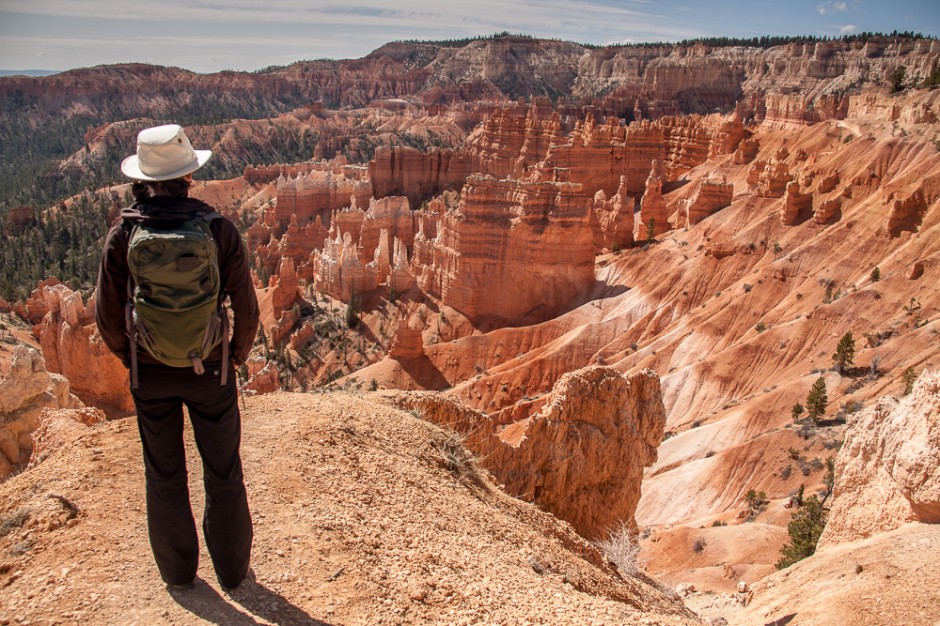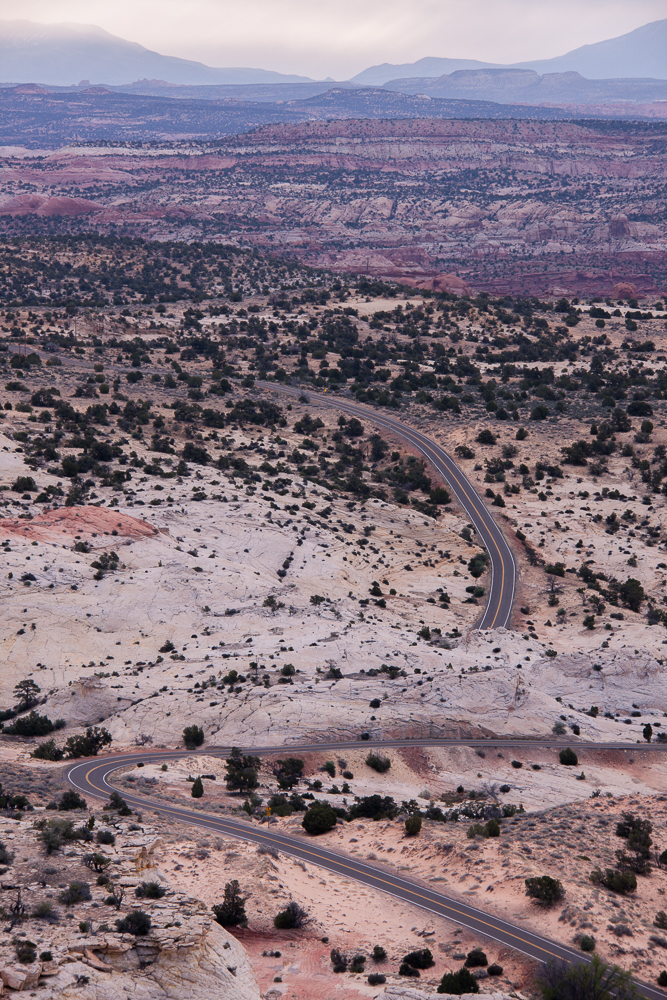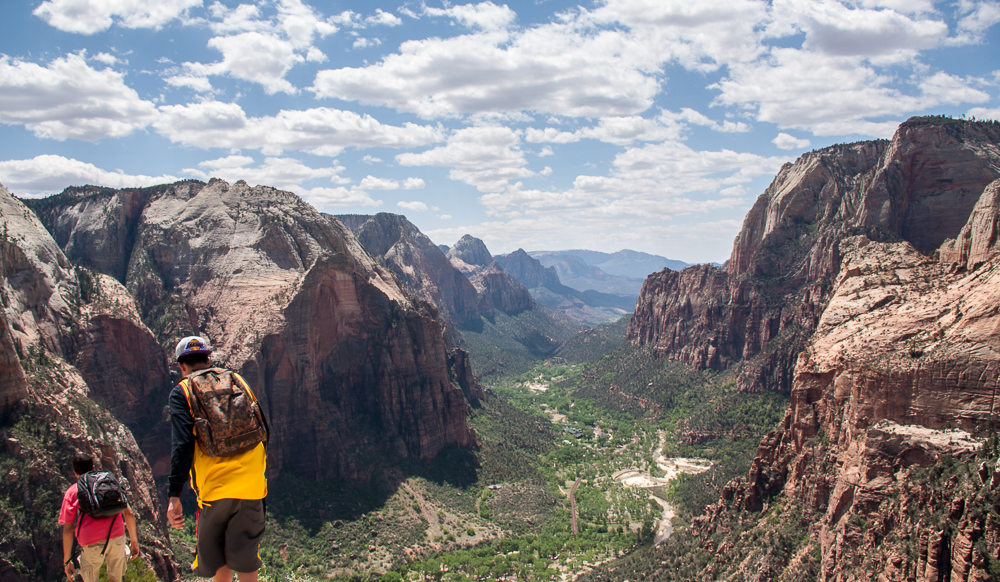1. SPRINGDALE
You’d never guess by visiting that Springdale is a town of only 500 permanent residents; that’s because it sees around 2.5 million people passing through it every year.
What’s around
- Zion National Park – It’s the 8th most visited national park in the US, for good reason. Most of the park is accessible only by foot, bike, or regular shuttles. Car access is strictly limited to reduce the impact of visitors.
- Bryce Canyon National Park – It’s less than two hours away and you get to drive through the east section of Zion, which shouldn’t be missed.
- Cedar Breaks National Monument – This is a 3-mile-wide/half-mile-deep natural amphitheater on the western end of the Colorado Plateau.
- Mountain biking trails – There’s so much great riding in the area, including Gooseberry Mesa and the J.E.M. trail.
Where to eat and drink
There are a lot of dining options. This is by no means an exhaustive list.
Breakfast and lunch
- Cafe Soleil – My go-to for breakfasts. Their Superfood Green Salad is an amazing mix of kale and greens and cabbage and berries and nuts and…too much to list. Just try it. This place was also local-residents-approved and is gluten-free friendly.
Ethnic cuisine
- Thai Sapa – It’s a bit of a fusion restaurant, not straight-up Thai food. I recommend the “thaijitas.”
Fresh food on the go
- Sol Foods Supermarket – There’s a great deli at the back to get fresh sandwiches to take with you on your day trips. Also a nice selection of freshly baked goods.
Brewpub
- Zion Canyon Brewing – They’ve been handcrafting ales since 2006.
Dinner
- Whiptail Grill – Tex-Mex and Asian fusion in an old, converted gas station.
- Bit & Spur Restaurant and Saloon – Along with a great-looking menu, they have Southern Utah’s largest selection of microbrews.
- Oscar’s Cafe – A locals’ favorite.
More handy resources
- Where to get outfitted – There are lots of oufitters in town to rent gear for hikes like the Narrows in Zion. My partner and I went with a guide from Zion Adventure Company on a canyoneering expedition just outside the park. As it was a wet canyon, we were outfitted with dry suits, dry bags, and coveralls and were guided through a spectacular canyon that only ZAC had access to. (Watch the video.)
- Where to connect with locals – Community centers are a great hub in any location to plug into the local scene. I took some yoga classes at the Canyon Community Center and struck up a nice connection with the teacher and other students.
2. MOAB
The Moab of Edward Abbey’s days is long gone, but I loved it when I was there this past April. There’s a vibe of adventure that emanates from the visitors in town, and it’s the prime location to base yourself for many of Utah’s most iconic desert adventures: mountain biking, hiking, rock climbing, canyoneering, river rafting. All that, and the street parking is free.
What’s around
- Arches National Park – Huge rocks balancing on delicate perches, slot canyons, natural formations that seem to defy physics. There are lots of easily accessible views, but also the opportunity to get off the beaten path and away from the crowds. Whatever you do, don’t miss Delicate Arch.
- Dead Horse Point State Park – 2,000ft sheer sandstone cliffs drop to a valley far below that contains the winding Colorado River. For hiking and biking, this is a great place to get away. The Intrepid Trail system has something for everyone, from green circles to black diamonds.
- Canyonlands National Park – Island in the Sky, the Needles, the Maze. From most accessible to least, these three distinct regions of the park offer travelers of all physical and survival abilities plenty of adventure.
- Slickrock Trail – Slickrock is what the pioneers of the area called this type of rock, because their shoed horses kept slipping on it. Once you step foot or set tire to it, though, you’ll realize this is a complete misnomer. It grips like glue. The Slickrock Trail is a technically advanced route that draws mountain bikers from all over the world.
- Colorado River – You’d be remiss to not see the alien-like landscape that is the Colorado Plateau from the water. If you’re not experienced enough to bring your own watercraft, book a tour with a local guiding company. Choose from half-day to multi-day adventures.
- Fisher Towers – 20 miles out of Moab via the scenic Highway 128 is this area of vertical sandstone walls, towers, and spires. Hikers can explore the area by foot; the more adventurous may want to climb one of the multi-pitch towers and yell your choicest celebratory obscenity from the top.
- Indian Creek – Another rock-climbing haven, this one for the crack-lovers. Historians take note as well: There are lots of petroglyphs that date back as far as 1,500 years.
- La Sal Mountains – If you’re in Moab in the dead of summer, this may be the place for you to cool off a bit. There’s a 60-mile loop that takes in Castle Valley (more rock-climbing opps here) and eventually enters national forest land.
Where to eat and drink
Fresh and organic
- Moonflower Community Cooperative – One-stop shop for your whole and healthy foods. They have a fridge with ready-made sandwiches and salads that are great to-go for day trips out of town.
Breakfast / coffee
- Love Muffin Cafe – Excellent espresso-based drinks and a tasty huevos rancheros.
- Eklectica – A “quintessentially” Moab experience, according to local climbing guide Nate Sydnor.
Ethnic cuisine
- Singha Thai — I ate here twice.
- Sabaku Sushi — Nate lived in Seattle and San Francisco, two places no strangers to raw fish. He says it “measures up.”
Classic American
- Milt’s Stop & Eat — Grass-fed, hormone-free beef and deadly shakes.
Finer dining
- Desert Bistro — Gourmet Southwestern cuisine inside an old dance hall built in 1892.
More handy resources
- Laundry – After filling up your canteens at GearHeads (free filtered water), you can stop by Moab Laundry Express, located in the same complex. It’s 24 hours and has free wifi and a flatscreen TV.
- Internet – Besides the laundromat, you can get free wifi at the Moab Tourism Center as well as at the Grand County Public Library (no password required). Some restaurants and cafes also offer free wifi.
- Entertainment – Moab’s Backyard Theater is a great little outdoor venue just off Main Street. Free live bluegrass every Wednesday night!
- Shade – It can be hard to find nice shady areas. Seek respite in grassy, treed Rotary Park where you can also play gigantic musical instruments that are permanently installed there.
- Local-interest books and maps – Back of Beyond Books is an independently run bookshop that takes its name from the works of famed local author Edward Abbey (it’s from The Monkey Wrench Gang). The store is, says Nate, where “you’ll find the best selection of literature for local history, Colorado River history, maps, etc.”
- Yoga – If you’re planning to do much hiking, biking, and climbing, a little yoga will go a long way for your well-being. Moab Yoga is the local studio, offering a variety of classes every day except Sunday. Drop in is $15.
- Fresh local produce and crafts – The Moab Farmers’ Market takes place every Thursday in Swanny City Park. Lots of local vendors selling fresh produce, massages, local crafts, and the like.
3. SALT LAKE CITY
Driving through Utah is like exploring backcountry roads, even on the main highways. Except for SLC, that is. This major metropolitan area is definitely on a different scale from the rest of the towns on this list, but whether or not you’re a big city person, you can’t argue its proximity to some excellent nearby adventures, or its options in terms of culture and cuisine.
What’s around
- Great Salt Lake Desert – To the west of SLC is the Bonneville Salt Flats, America’s answer to the Salar de Uyuni in Bolivia. It’s the largest of the salt flats in the region and home to many land speed records. It’s public, managed by the Bureau of Land Management (BLM), and visitors are free to attend any of the annual land speed events (e.g., World of Speed) as well as drive on the flats themselves.
- Utah Lake State Park – At 96,000 acres, Utah Lake is the largest body of fresh water in the state. Lots to do here, including: fishing, boating, sailing, camping, hiking, wildlife watching, swimming, wakeboarding…you get the picture.
- Flight Park State Recreation Area – If you want to take to the air, this is the place to do it. It’s known round the world as one of the best training sites for activities like hang-gliding and paragliding. Never tried it before? Take a course or go tandem!
- Antelope Island State Park – A next-door nature respite from the hustle of the big city, there’s lots of single- and double-track mountain biking (21 miles of trails), boating and watersports, horseback riding, camping, and — in the winter — snowshoeing and cross-country skiing.
- Big Cottonwood Canyon – Frequented by botanical lovers for its wildflowers and unique plant life, there’s ample hiking to be had here in the summer months, as well as rock climbing. Snowshoeing and skiing in the winter.
Where to eat and drink
Breakfast & brunch
- The Park Cafe – Located in Liberty Park, it’s been around since 1984.
- Cafe Niche – A community-focused restaurant with an “emphasis on supporting local farms, ranchers and food purveyors for the most flavorful ingredients around.”
Ethnic cuisine
- Takashi – I’m always hesitant to have sushi this far away from a coast, but sometimes you just gotta have some raw fish, and Takashi does it right.
- Oh Mai – I love Vietnamese food, almost as much as I love a good pun.
Food cart
- If you’re into food carts, check out Tacos Hildago — one of the best.
Local breweries
- There are several local breweries in SLC. The scene’s been expanding since 1986, which is when Wasatch Brewery opened.
Farmers market
- Even in the winter SLC is home to a farmers market. The Winter Farmers Market runs every other Saturday through April. The Summer Market starts in June.
Cool things to do in SLC
- Mormon Tabernacle Choir – They have five gold records, and two have received platinum status. MoTab’s legit.
- Twilight Concert Series – For a different but equally impressive music experience, check out SLC’s TCS, which brings top-name national acts to downtown Salt Lake’s Pioneer Park on July and August Thursdays. Best part? Tickets are just $5!
- Natural History Museum of Utah – Once you see what Utah looks like, you’ll likely want to understand how it came to look that way, as well as get a better understanding of the first peoples and animals (dinosaurs!) that inhabited this unique landscape.
- Nightmare on 13th – If you’re visiting around Halloween, this is the spot. It’s one of Utah’s largest and longest running haunted houses.
- The Wairhouse Trampoline Park – Got kids? Don’t have kids? Whatever, jumping on trampolines is fun. Not only that, but it’s fantastic for a healthy lymphatic system.
4. ESCALANTE / BOULDER

Bryce Canyon National Park. Photo: Author
I’m lumping these two tiny towns (that have a combined population of about 1,000) together because they’re less than 30 miles apart, share the same beautiful landscape and access to adventure, and are connected by one of the most dizzying roads I’ve ever driven on.
What’s around
- Scenic Byway 12 – This mighty engineering feat traverses super rugged and isolated terrain, connecting Capitol Reef and Bryce Canyon National Parks. The almost 30 miles of it between Escalante and Boulder is stunning and includes the “Hogsback” — a section where the land drops off sharply on either side of the highway.
- Lower Calf Creek Falls – A well-trekked hike located between Escalante and Boulder, in Grand Staircase-Escalante National Monument. The trailhead for the 6-mile hike to the 126ft waterfall is in the Calf Creek Campground. If you’re not camping there, it’s $2 to park.
- Upper Calf Creek Falls – Much less visited is the upper tier of Calf Creek Falls, an 88ft waterfall. One reason it’s much less visited is because the trailhead is unsigned, making it difficult to find. If you’re keen, look for two large boulders on the side of the road between mile markers 80 and 81.
- Capitol Reef National Park – The defining feature of this park is the Waterpocket Fold, an almost 100-mile-long monocline, which translates to 100 miles of rugged backcountry adventure options. The history of the Mormon pioneers who settled this wild area in the 1800s is very interesting.
- Bryce Canyon National Park – The landscape of Bryce Canyon is unmistakable. Bright red hoodoos shoot up from the canyon floor; get up close and personal on a hike.
- Grand Staircase-Escalante National Monument – At 1.7 million acres you won’t be taking it all in, but it’s home to varying landscapes — canyons, mesas, buttes, pinnacles — explorable by vehicle and on foot.

Scenic Byway 12. Photo: Author
Where to camp
The Calf Creek Campground is one of the most scenic campgrounds I’ve ever stayed at. It sits at the bottom of a big cliff along the creek and is where the Lower Calf Creek Falls trailhead is. There are 14 first-come, first-served sites at $15 per night.
Where to eat and drink
In Boulder
For a town of around 200 people, Boulder has surprisingly good cuisine. Hell’s Backbone Grill serves up produce from its own organic farm and Boulder-raised, grass-fed and -finished lamb and beef. The Burr Trail Grill and Outpost Store is right next door, with local arts and crafts and also an espresso bar.
The Kiva Koffeehouse is about 20 minutes outside Boulder and close to the Calf Creek Campground. It’s one of those you-should-stop-and-check-this-out places, if nothing else than for the building and its setting. It’s a beautiful circular structure made out of massive ponderosa pine logs and lots of glass to overlook the landscape.
In Escalante
The Escalante Outfitters Cafe has, according to my partner, the best gluten-free pizza crust. I do eat gluten and tried a slice and thought it was excellent. That’s saying a lot.
Where to shower and do laundry
In Boulder
The Hills and Hollows Market — where you can also get fresh, organic, and fair-trade foods, as well as gas — offers showers for 5 bucks. Ask at the counter.
In Escalante
Canyons of Escalante RV Park has very nice laundry and shower facilities. They also rent cabins.
5. KANAB
Perhaps the best situated for access to several national parks, state parks, and monuments, Kanab is also known as “Little Hollywood” because it’s been the backdrop for many a Western film and TV series.
What’s around
- Zion National Park – Just 40 minutes away.
- Bryce Canyon National Park – Around 1.5 hours away.
- Grand Staircase-Escalante National Monument – Close access to Cottonwood Canyon Road, a dirt track which takes you into the heart of the monument (high-clearance vehicles recommended; impassable in wet weather).
- Coral Pink Sand Dunes State Park – 20 miles from Kanab, these unique sand dunes are the result of eroding Navajo sandstone. Hiking and off-road motoring are popular here.
- Buckskin Gulch – Located in the Paria Canyon-Vermilion Cliffs Wilderness Area. At 21 miles, it’s considered the longest slot canyon in the world. Adventurers canyoneer this route in two days. Do not attempt if chance of rain!
- Coyote Buttes South – Accessible from the Cottonwood Cove Trailhead just east of Kanab, this is an alternative to visiting the hard-to-get-lottery-permits-for the Wave. Permits are required and can be purchased at the Grand Staircase-Escalante National Monument visitor center in Kanab.
Where to eat and drink
- Rocking V Cafe – Open daily from 11:30am to 10pm, it has an eclectic menu. Can be considered on the pricey side.
- Escobar’s Mexican Restaurant – If you’re up for a late breakfast, they open at 11am and serve huevos rancheros, among a few other choices. Be quick though — breakfast ends at noon.
Other points of interest
- Little Hollywood Movie Museum – Check out some of the Old Western movie sets (and more) that have been preserved here. Admission is free.
- Best Friends Animal Society – There are four free tours per day of the sanctuary, which has a No Kill Mission.
